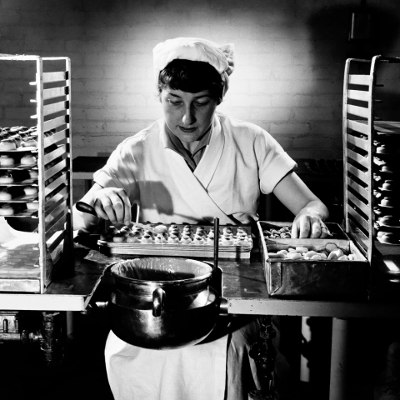Chapelfield Works

Mackintosh-Caley's story begins in 1857 when chemist Albert Jarman Caley opened a shop on London Street, Norwich.
In 1863 he started making mineral water in the cellar of his shop. This proved to be profitable venture - so much so that by 1880 he had expanded the business into a small factory in Chapelfield which was known as the Fleur-de-Lys works.
Soft drinks were seasonal in their sales, so in 1883 Caley's expanded into cocoa production for sale during the winter months. Chocolate manufacturing followed soon after, beginning in 1886, and in 1897 the company diversified again when they started making Christmas crackers.
In 1890 a new, larger factory was built on the Chapelfeld site and by 1904 the company employed around 700 people. Their products were now exported around the world.
At the start of the 20th century Swiss milk chocolate began to flood the British market, and Caley's were determined to match its superior quality. They installed a plant similar to the ones used in Switzerland and partnered with a local farmer to supply the factory with the richest milk from his herd of Red Poll cattle. Caley's soon became known for the quality of their milk chocolate.
Norfolk Museums Service has a number of machines from the Chapelfield factory in its collections, including a chocolate enrobing machine, which is on display at the Museum of Norwich at the Bridewell. This machine coated fillings like marzipan or fudge with chocolate.
The firm remained in the hands of the Caley family until 1918, when it was purchased by The African and Easter Trade Corporation. In 1932 the firm was acquired by John Mackintosh and Sons Limited of Halifax, makers of the popular brand Quality Street, for the sum of £138,000.
Watch a selection of adverts for Quality Street from 1958-1969 on the Yorkshire Film Archive website.
The Chapelfield factory went on to produce the first pack of Rolos for Mackintosh in 1937. They proved so popular, the factory was soon producing two tons of Rolos an hour.
During the Second World War, the Chapelfield factory was destroyed by fire after an incendiary raid on Norwich. Rebuilding work began in 1946, but the full reconstruction was not completed until 1952.
In 1953, the mineral water business was sold to a local brewer.
With the opening of the factory came a succession of new products, including Week-End and Munchies in 1957, and Caramac in 1959.
By 1953, the company employed over 4,000 staff across the Norwich and Halifax branches.

There are sweet-making tools in the Museum of Norwich's collection. They were used by workers at Mackintosh-Caley's Chapelfield Works in the first half of the 20th century, until they were superseded by machine processes. By the time Walter Nurnberg visited the factory, these tools were being phased out.
Go to YouTube to watch a short film from the 1950s showing a chocolate-maker using a wire tool to create patterns on top of chocolates (starting at around 1 minute 28 seconds).
Objects in our collection
More Chapelfield Works artefacts
See more (Go to Objects in our collection)






